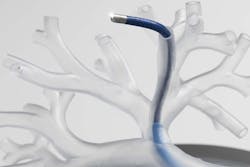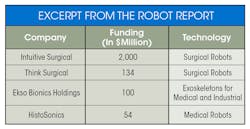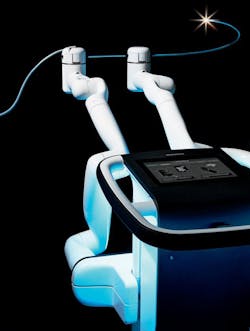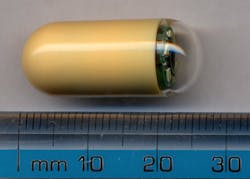Robots Are Invading America’s Operating Rooms
Being highly regulated can slow down industries such as healthcare, though often for good reason. Nevertheless, medical technology is moving faster than ever before. It seems like each year it’s possible to delay a surgery, the better and less invasive a procedure becomes. (As a runner, I’m hoping that in a few decades knee replacements will be simple procedures with minimal recovery time.) And many of the ways in which doctors and engineers are reducing recovery time don’t involve opening a patient to begin with.
Miniaturizing devices such as scopes and cameras let doctors inside the human body do some incredible things. Devices such as the endoscope (a flexible tube with a light and camera attached) or laparoscope (another type of small camera that is used to see inside a body) are helping doctors get patients back on their feet faster. Using these small devices in tight spaces can be difficult, and since around 2000 robotics have been used to further surgical technologies. Smaller medical tools with robotics have been used in millions of procedures, both exploratory and surgical. Going forward this industry will continue to grow, and more companies are entering it.
The ability to miniaturize technology to see and even operate inside the body with smaller incisions is helping patients recover faster. This technology has changed the medical industry. However, skeptics are questioning whether involving robots in surgery is worth the current cost. (Credit: Auris Health)
The following will survey at some resources and news items to see what type of robots will be entering the operating room and what procedures are using this technology.
Companies and Investments
Perhaps the earliest example of advanced robotic making medical procedures less invasive is the da Vinci surgical system, which has features to help steady the surgeon’s hands and help make smaller, more-precise moves inside the body. Patients have less recovery time with smaller incisions. In August 2015, the Emergency Care Research Institute (ECRI) published a PDF on Robotic Surgery. The report said while there are growing number of procedures involving surgical robots—a 178% growth from 2009 to 2014—there have also been 144 deaths related to them (they didn’t say caused by, just related).
“The evidence isn’t strong enough to determine whether or not a robot is better than traditional minimally invasive surgery, but the evidence does indicate that it’s better compared to open surgery — more evidence from higher quality studies may change this conclusion,” said Chris Schabowsky, Ph.D., a program manager at ECRI in an article from Healthline. Robotic surgery is also much more expensive, so some are questioning if the additional costs are worth the benefit. Additionally, with the success of laparoscopic surgery, what are the benefits of robotic surgery compared to the costs?
Despite these lingering concerns and questions, the da Vinci system has made more money than expected. Perhaps da Vinci’s profits and the growth in robotic surgeries are what other companies are focusing on, as there are several other companies looking to enter the market. The ECRI’s PDF from 2015 mentions three types of da Vinci models, and four other manufacturers that have received or are planning to receive different regulatory permissions. More recently, The Robot Report published 20 of the largest robotic investments during the first half of 2019. Four of the companies presented are associated with robotic technology for the medical industry, with Nos. 1 and 11 specifically focused on robotic surgery.
Excerpt from The Robot Report:
Auris Health wasn’t even on the list but was acquired by Johnson and Johnson for $3.4 billion. While The Robot Report noted that the “acquisition is one of the 10 largest VC-backed, private M&A transactions of all-time and will be both the largest robotics and largest med-tech private M&A deal in history,” Johnson & Johnson published that Auris Health could get $2.35 billion more depending on reaching predeterminate milestones.
Lung cancer kills more people per year than colon, prostate, and breast cancer combined. This could largely be due to the difficulty of testing for different cancers. The Monarch Platform from Auris is working to detect lung cancer sooner and less invasively with its robotic platform. (Credit: Auris Health)
With so much money and concern over medical surgery, it might take more time and research to determine the right direction. With the population living longer, and the older population increasing, robotic surgery might be a way to alleviate surgeons to help more patients. Surgical robots might also help automate some processes or procedures to reduce the time a surgeon needs in the operating room or lighting the doctors work load.
The da Vinci system marketing mentions providing ergonomic, comfort, and other benefits. While some argue over the benefit-to-cost ratio of robotic systems, it may keep surgeons operating into older age and help reduce muscular and skeletal problems associated with long tedious surgeries.
Robotic Procedures
“86% of urology residency programs in the U.S. have a da Vinci System,” said UC Health, adding that “All 42 gynecologic oncology fellowship programs in the U.S. have a da Vinci System.” According to an article in Science Direct younger males with private insurance in the U.S. seem to be driving robotic surgery procedures. The article and multiple other sources mentioned stomach, gallbladder, pancreas, spleen, colon and rectum, hernia (general surgery), prostate or kidney (urologic surgery), and ovarian or uterine (gynecologic surgery).
The shrinking size of technology lets this small pill be swallowed and take thousands of pictures through the digestive tract. Pictures are collected on a device that is worn like a belt by patient. As technology shrinks patients can expect more innovations and, hopefully, lower costs with greater comfort. (Courtesy of Wikimedia Commons)
Many of the applications involve larger, relatively simple passageways through the body. Auris, mentioned earlier, has used endoscopic technology to look in smaller and more complex areas. While robotic exploration and surgery has helped the colon and prostate, according to Auris, more people die from lung cancer than both cancers combined.
A new platform is being developed to access hard-to-reach nodules of the lung in a non-invasive way to find lung cancer earlier. The endoscope lets a doctor see inside a patient and obtain a sample of tissue for testing. If this platform performs as well as the company envisions, the ability to have a robot get into such fine opening and complex structures could have this technology entering other part of the body for exploration and earlier detection of diseases. This technology is already been used in tests for gastrologic and urology applications.
The smaller and more nimble robotic technology becomes, the easier it will be to access the body in less-invasive ways. Robotic surgery might help increase in research or resources for soft robotics to be used in medicine, too. With multiple resources predicting the growth of the robotic medical market, it will be interesting to watch how medical technology drives other markets.
Market Size
With the success of the da Vinci system, the size of the medical market, and issues related to robotic surgery being reduced, robots in the medical field will continue to grow.
- Global Markets Insights: Global Surgical robots’ market is expected to surpass $24 billion by 2025
- Business Wire: Robotic Surgery Market Expected to More than Double to $7 billion by 2025 – New Study by iData Research
- Allied Market Research: The global surgical robotics market is likely to reach $98 billion by 2024, experiencing a compound annual growth rate of 8.5% from 2017 to 2024.
- BIS Research: The global surgical robotics market is expected to reach $11.65 billion by 2025. The market consists of various product segments such as surgical systems, instruments and accessories and maintenance services.
- Markets and Markets: The surgical robots market is expected to grow from USD 3.9 billion in 2018 to USD 6.5 billion by 2023, at a Compound Annual Growth Rate (CAGR) of 10.4% during the forecast period.
These numbers might be different, but they all agree that robotic surgery is increasing. It will be interesting to watch what companies entering the market are patenting. Patients might offer a glimpse to the design differences between drives and controllers that make each system precise and safe for patients. Additionally, anyone in the robotic surgery field will be under constant observation to make sure these new medical tools are justifying the increased cost they bring to the operating table.





